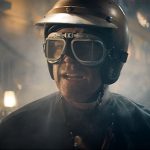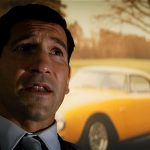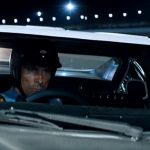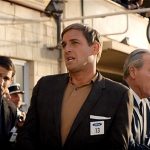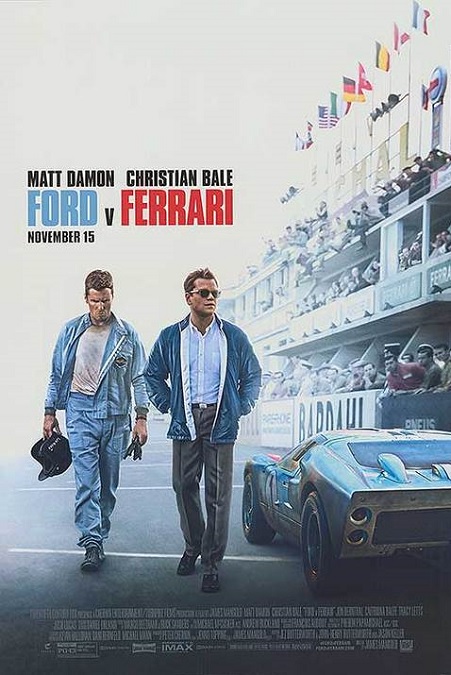



Ford v Ferrari – 2019
This movie was good. There is no doubting that. But I have to admit a certain disinterest in the subject matter. I try not to let that color my appraisal of the film’s merits, of which there were many. But auto racing has never been an interest of mine. That being said, the film was able to stir my emotions in the way that I think it was trying to, so in that respect, it succeeded. I’ll explain.
One of the things that has always prevented me from enjoying professional racing has been the possibility of an accident. I simply have no interest in watching such a horrific event. It helped to know that every accident that occurred in this movie was planned and filmed in a controlled environment. The special effects team did a great job with the realism of the crashes and explosions. But I suppose that, for many fans, that thrill and that danger is part of the attraction to the sport.
And as for that, they did a fantastic job of putting the viewers on the road with them, hurtling by at those incredible speeds. It really brought the dangers of professional racing to the screen in an incredible way. Granted, this has been done in cinema many times before, but here, they did it better. I instinctively felt afraid for the safety of the drivers who were racing at speeds up to, and over, two hundred miles per hour.
But the movie was much more than that. First, we had two very good actors playing the leads. We had Matt Damon playing the part of Carroll Shelby, one of the best racecar designers and manufacturers in the world. Opposite him was Christian Bale, playing one of the best race car drivers in the world, Ken Miles. He was a man with an attitude, who was portrayed as having a near magical talent when racing. The two had a good on-screen chemistry and shared the screen well.
The more I see of Matt Damon, the more I am convinced of his skill as an actor. He continues to impress me in every roll he plays. He has a kind of likeable ease about him that always makes him a pleasure to watch. Unfortunately, I have never been a huge fan of Christian Bale. I think he is a very good actor, but he has a habit of playing rolls that I don’t like to watch. He plays people with attitude and sometimes downright jerks. There is no doubting his skill in front of the camera, but he seems to play these parts a little too well.
Also in the film were Jon Bernthal as Lee Iacocca, the man who thought to get Ford into the big race against Ferrari, Tracy Letts as Henry Ford II, owner of Ford, Caitriona Balfe as Miles’ wife, Mollie, Noah Jupe as Peter, Miles’ son, and finally, the movie’s main villain, Josh Lucas, playing Leo Beebe, the Senior Executive Vice President of Ford Motors who put his dislike of Miles above the idea of winning the movie’s big race, the 1966 24 hours of Le Mans, a race which, at the time, was always dominated by the Italian automobile, the Ferrari.
And there was the movie’s main driving plot device. Henry Ford II was insulted by Enzo Ferrari, and thus became obsessed with defeating him in the big race. But I thought the secondary conflict was the much more interesting one. Ford executive Leo Beebe didn’t like Miles, and tried to get rid of him at every turn. He didn’t understand, or didn’t care, that Miles was the best man for the job.
In the end, Leo tricked Miles into losing the race. I mean, we all knew that the Ford underdogs were going to win. But we all wanted to see Miles come in first. Instead, Leo asked that Miles cross the finish line at the same time as the other two Ford drivers in the race for the sake of a fantastic photograph. Even though Miles was far ahead of the others, he slowed down so they could get that photo of the three Fords crossing the line together. But since one of the other two drivers had been farther back in the starting line-up than Miles, the other man won.
So, as I usually do when a film is based on real events, I did a little reading to see if the movie was historically accurate. Did Leo Beebe really trick Miles into losing the race that he should have won? Or was this just made up to make the film more dramatic? Well, apparently, it is true that the three cars crossed the finish line together, at Beebe’s suggestion. However, his motives in making that call may have been fabricated. When asked about it in later years he said that his decision at Le Mans was partly because he was worried over safety and financial concerns. He didn’t want drivers to “knock one another off” in their race to victory.
I was pleased to learn that most of the driving in the film was done in real cars as opposed to CGI cars. The special effects were limited to digitally altering pre-filmed backgrounds to make them historically appropriate, creating stadiums full of cheering fans, and adding rain effects at the 24-hour race. For safety reasons, they also sped up some of the racing sequences to make it look more like two hundred mph instead of fifty. It was all done well, but I’m just not a big racing fan.
